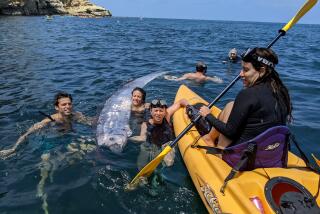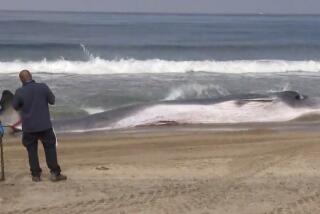Rescued sea turtle gets 3-D printed brace for cracked shell
Just in time for the holidays, a loggerhead sea turtle at Birch Aquarium in La Jolla got a perfectly fitting gift.
The turtle, rescued in 2013 with a broken shell and twisted spine, this month received a 3-D printed brace that fills a gap in her carapace, the upper portion of her shell.
Gliding recently in her tank at the aquarium, she swam up to the glass to investigate visitors and eagerly munched fish her handlers provided.
It’s a big improvement from her condition four years ago, when she was found in the canal of a New Jersey power plant, emaciated and injured.
She weighed less than 100 pounds and her shell was cracked, with a plate-sized chunk missing from the right rear side. She had both scoliosis and lordosis — sideways and vertical curvature of her spine — and her rear flippers were paralyzed.
Rescuers didn’t know how she got hurt, but they transferred her to an aquarium in South Carolina. There the staff stabilized her for transfer to a permanent facility after determining that she could never be released to the wild.
“Birch agreed to take her knowing she would be a long-term patient who would require care as long as we had her,” said Jenn Moffatt, senior director of animal care for the aquarium, which is part of Scripps Institution of Oceanography at UC San Diego.
That could be quite a while. Her handlers aren’t certain of her age, but estimate that she’s a 10- to 15-year-old juvenile. Loggerheads, known by the scientific name Caretta caretta, reach maturity at 35 years, according to the National Oceanic and Atmospheric Administration. Authorities say their life span is over 50 years and possibly up to 100. The turtles are found around the world, and are listed as endangered.
“So we want to protect every one,” said Jennifer Frohlich, a veterinarian with UC San Diego who assisted with the turtle’s care.
Birch Aquarium received the turtle in November 2014, and after running blood work and other tests, introduced her to the tank where she is on display.
She grew from 75 to 215 pounds, approaching her expected adult weight of about 250 pounds. But the growth aggravated her condition, putting her at risk for complications, Moffatt said. Aquarium team members knew they would eventually have to fix her shell to keep her healthy and prevent further damage to her spine and organs.
Consulting with doctors, veterinarians and other experts at the university, they considered various procedures, ranging from surgery to external bracing. They were seeking the least invasive option, and hit upon 3-D printing several months ago.
The turtle has received a CT scan at UC San Diego’s Thornton Hospital twice since her arrival to monitor changes in her shell, the aquarium said. So the team used those CT scans and their own 3-D scanning techniques to design a rigid plastic brace that molded to her shell.
Researchers tested several prototypes and identified one that fit perfectly. They fabricated the final version using 3-D printers, which create a three-dimensional object from a digital model.
They chose an epoxy that was safe for the turtle and would hold the piece securely. Two weeks ago, they fixed it to her shell, where it set underwater.
The procedure went smoothly, they said, and had the benefit of restoring her to neutral buoyancy; previously, her rear end tended to float up because of her damaged shell.
Over the past couple weeks, the young loggerhead is as hungry, alert and curious as ever, Frohlich said.
“Loggerheads are very charismatic, very friendly,” she said. “They’re the Labrador dog of sea turtles. She’s very charismatic and knows when people are in front of the tank, and she hams it up.”
deborah.brennan@sduniontribune.com
Brennan writes for the San Diego Union-Tribune.
More to Read
Sign up for Essential California
The most important California stories and recommendations in your inbox every morning.
You may occasionally receive promotional content from the Los Angeles Times.











